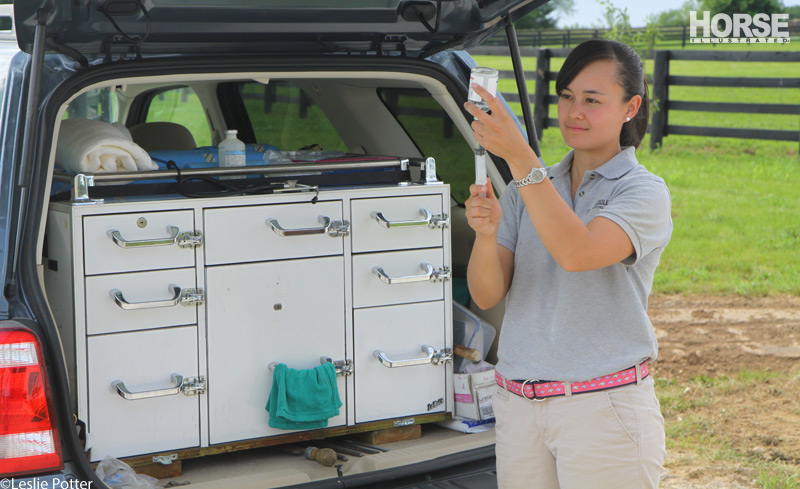
Does this sight send your horse into panic mode? Read on for advice on dealing with needlephobia. Photo: Leslie Potter
As a vet, I am always pleasantly surprised by the large percentage of horses that don’t seem to mind needles. Vaccines, blood draws, and intravenous or intramuscular medications are all part of a horse’s life at least once or twice a year and thankfully most of our half-ton friends hardly bat an eye when they get stuck. As for the small percentage that does mind, this is another story. From tap dancing and head tossing to outright rearing and striking in an attempt to avoid a stick, needlephobic horses are dangerous to the vet, the owner, and to themselves. Here are some tips to help and prevent needlephobia in horses.
It is important to note that horses that act needlephobic tend to be more anxious about the events leading up to the needle stick than the actual jab itself. This “whole scene” approach comes into play as you begin to desensitize your horse to needles.
Many vets will administer intramuscular injections, such as vaccines, in a horse’s neck. Prior to doing so, they will approach the horse on its side, possibly wipe the injection area with an alcohol swab, then pinch the skin prior to quickly inserting the needle. To desensitize your horse to this series of events, take each small step and repeat it (not including the actual needle stick, of course) until the horse no longer reacts to it.
As the initial step, approach your horse from the side and move your hand to the side of his neck. If he accepts this without a reaction, then go to the next step. If your vet uses an alcohol swab, slowly take a swab and approach your horse with it, carefully watching your horse’s body language. If he appears stressed or reactive, stop. Repeat your movements up until that point of reaction until you no longer get a reaction from your horse.
At this point you are actively desensitizing your horse to that step of the process. When you reach the point of no reaction, slowly and in incremental steps, continue, be that actually touching your horse with the swab, or pinching the neck. The determination of each step in this process is very much based on the individual horse, and of course what your vet’s process is. If your vet doesn’t use alcohol swabs, or administers vaccines somewhere else like the pectoral muscles in the chest, this will dictate what you desensitize your horse to.
Desensitization is a slow, methodical process that takes patience and understanding. Here are few things to keep in mind as you work with your horse.
- Work slowly. The worn cliché that Rome wasn’t built in a day also applies to horse training. You can never train a horse too slowly and it’s far better to go a little too slow than to rush things.
- Baby steps. Breaking the process into the smallest increments is key for success when using desensitization as a training tool. This also helps you understand what your horse is actually afraid or anxious of. Is it really the needle poke or is it the smell of alcohol?
- Vary the situation. Just as your desensitization program should mimic what your vet does, once your horse has mastered those steps, introduce small differences. For example, be sure when working with vaccine desensitization, to work with your horse on both sides of his neck. In the same manner, enlist the help of others. Once your horse is accustomed to you performing these steps, have a helper stand in.
- Safety first. If your horse is violently opposed to needles—so much so that he poses a threat to your safety—enlist the help of a professional trainer. Never persist with a highly reactionary horse, especially in an enclosed space such as a stall. Always know where your exits are when working alongside your horse. Use your understanding of your horse to guide you. Your gut will tell you a lot; if you are scared of your horse or even just unsure of how to move forward, seek professional assistance.
Get started on the right hoof. Training a young horse to accept needles and other veterinary procedures prior to his first experience is the best bet for future behavior. Practice touching your young horse on his neck and along his jugular vein so he learns to accept pressure in those areas. Periodically pinch his skin as the vet would to administer vaccines. If a young horse is exposed to these activities when they are not followed by a needle stick, he is less likely to become anxious when the vet arrives and does the same thing.
Needle fear in horses is no small thing and the earlier you can start working with a horse on this, the better. Unlearning a fear behavior can be challenging, but it is far worth it for safety in the future.
Liked this article? Here’s more on equine vaccinations:
Ask the Expert: Should Horse Owners Administer Vaccines?
Safe Equine Vaccinations
Administering Horse Medication
Anna O’Brien, DVM, is a large animal veterinarian in Maryland and a frequent contributor to Horse Illustrated magazine and horseillustrated.com. Follow her on Twitter: @annaobriendvm






good advice
a
Great advice and we used many of these same techniques in working with our horses, especially with young stock or horses with previous bad experiences. We have had two horses in 4 decades of horse ownership who were extremely needle phobic. One overcame the problem with techniques similar to the ones listed above, but the other has never become comfortable with strangers giving injections. She does best when handled by professionals skilled in using “mosquito” technique (slowly and gently sliding the needle in versus the quick hard jab some use) as she is fine with all the preliminaries but reacts when the actual needle penetrates. My current vet also sometimes uses distraction techniques such as having a hose running on one of her legs while drawing blood or sedating her for her yearly dental. At home, we can give her shots and injections ourselves just with careful attention to our technique so hopefully she’ll eventually allow new veterinary professionals to give her injections without any drama too.
I only partially agree….I have a needle phobic mare who apparently had been tied to a post when she was a foal…..at age 6 I got my hands on her and have been preparing her for an upcoming annual booster etc with a seringe with a tooth pick inserted as the needle….and treats. This only prepares the grounds but the vet needs to take his time in touching, preparing the needle site, talking etc….today, 6 years later we are at a point where with caution and being slow a vet can vaccinate or insert a needle without big drama from her side.
My Arabian mare has horrible needle phobia. She has it so bad that two vets couldn’t. Desensitizing hasn’t worked. A foal roll has worked. Seeing a needle she still tenses up when she sees it. For two months she had a needle near her food dish and would push it away with her hoof. I’m a retired RN and have work with this horse for years. Foal roll is the only way.
I have this problem as well as others with my 6 year old gelding. I just got him. But tell me, please, what I a foal role?